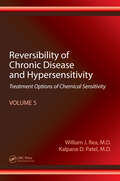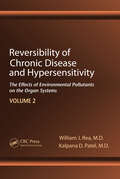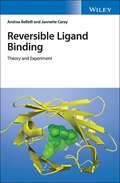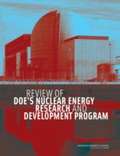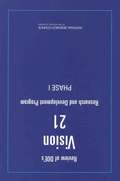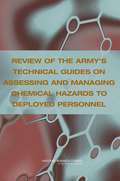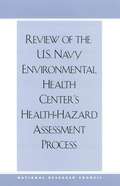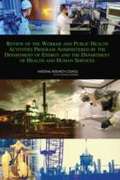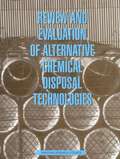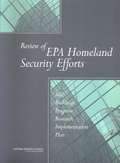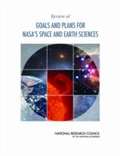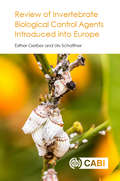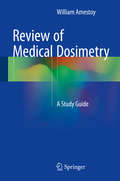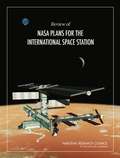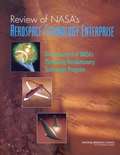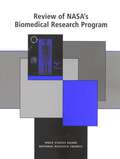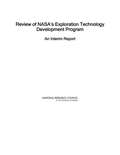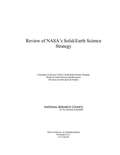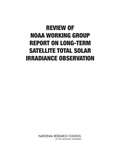- Table View
- List View
Reversibility of Chronic Disease and Hypersensitivity, Volume 5: Treatment Options of Chemical Sensitivity
by William J. Rea Kalpana D. PatelThe clinical approaches to the chronic degenerative diseases that drain our resources, and compromise our well-being, have become almost exclusively symptom-focused. The common wisdom is that they are idiopathic with final outcomes to be managed rather than prevented or cured. That they are potentially reversible rarely enters any discussion between doctor and patient. Reversibility of Chronic Disease and Hypersensitivity, Volume 5: Treatment Options of Chemical Sensitivity, the final volume of this set, offers a much different perspective on chronic degenerative disease; one that disputes the idiopathic label attached to most, as well as the usual fatalistic prognosis.
Reversibility of Chronic Disease and Hypersensitivity,Volume 2: The Effects of Environmental Pollutants on the Organ System
by William J. Rea Kalpana D. PatelEncyclopedic in scope, Reversibility of Chronic Degenerative Disease and Hypersensitivity, Volume 2: The Effects of Environmental Pollutants on the Organ System draws deeply from clinical histories of thousands of patients. It focuses on clinical syndromes within the musculoskeletal, gastrointestinal, and respiratory systems. The book explores mech
Reversible Ligand Binding: Theory and Experiment
by Andrea Bellelli Jannette CareyPresents the physical background of ligand binding and instructs on how experiments should be designed and analyzed Reversible Ligand Binding: Theory and Experiment discusses the physical background of protein-ligand interactions—providing a comprehensive view of the various biochemical considerations that govern reversible, as well as irreversible, ligand binding. Special consideration is devoted to enzymology, a field usually treated separately from ligand binding, but actually governed by identical thermodynamic relationships. Attention is given to the design of the experiment, which aids in showing clear evidence of biochemical features that may otherwise escape notice. Classical experiments are reviewed in order to further highlight the importance of the design of the experiment. Overall, the book supplies students with the understanding that is necessary for interpreting ligand binding experiments, formulating plausible reaction schemes, and analyzing the data according to the chosen model(s). Topics covered include: theory of ligand binding to monomeric proteins; practical considerations and commonly encountered problems; oligomeric proteins with multiple binding sites; ligand binding kinetics; hemoglobin and its ligands; single-substrate enzymes and their inhibitors; two-substrate enzymes and their inhibitors; and rapid kinetic methods for studying enzyme reactions. Bridges theory of ligand binding and allostery with experiments Applies historical and physical insight to provide a clear understanding of ligand binding Written by a renowned author with long-standing research and teaching expertise in the area of ligand binding and allostery Based on FEBS Advanced Course lectures on the topic Reversible Ligand Binding: Theory and Experiment is an ideal text reference for students and scientists involved in biophysical chemistry, physical biochemistry, biophysics, molecular biology, protein engineering, drug design, pharmacology, physiology, biotechnology, and bioengineering.
Reversing the Arrow of Time
by Bryan W. RobertsThe arrow of time refers to the curious asymmetry that distinguishes the future from the past. Reversing the Arrow of Time argues that there is an intimate link between the symmetries of 'time itself' and time reversal symmetry in physical theories, which has wide-ranging implications for both physics and its philosophy. This link helps to clarify how we can learn about the symmetries of our world; how to understand the relationship between symmetries and what is real, and how to overcome pervasive illusions about the direction of time. Roberts explains the significance of time reversal in a way that intertwines physics and philosophy, to establish what the arrow of time means and how we can come to know it. This book is both mathematically and philosophically rigorous yet remains accessible to advanced undergraduates in physics and philosophy of physics. This title is also available as Open Access on Cambridge Core.
Reversing Deforestation: How Market Forces and Local Ownership Are Saving Forests in Latin America
by Douglas Southgate Brent SohngenDire reports of surging deforestation in the Brazilian Amazon appear often in international headlines, with commentators decrying the destruction of tree-covered habitats as an act of environmental vandalism. Although forest losses are alarming, broader trends are bending in the direction of forest recovery. In this book, Brent Sohngen and Douglas Southgate address the long-term recovery of forests in Latin America. The authors synthesize trends in demography, agricultural development, and technological change, and argue that slower population growth and increasing crop and tree yields—in conjunction with protecting local ownership of natural resources—have encouraged forest transition. This book explores how market forces, ownership arrangements, and the enforcement of property rights have influenced this shift from net deforestation to net afforestation. Forest transitions have happened before, such as the recovery of tree-covered habitats in Europe and the United States. Signs of a similar transformation in land use are now present in Latin America. Ending deforestation requires a strengthening of forest dwellers' property rights while ensuring that biodiversity conservation is no longer treated as a value-less externality. The resulting forest landscape, actively managed for ecosystem services, will be more resilient, as is needed to overcome climate change.
Review Of Doe's Nuclear Energy Research And Development Program
by National Research Council of the National AcademiesThe National Academies Press (NAP)--publisher for the National Academies--publishes more than 200 books a year offering the most authoritative views, definitive information, and groundbreaking recommendations on a wide range of topics in science, engineering, and health. Our books are unique in that they are authored by the nation's leading experts in every scientific field.
Review Of Doe's Vision 21 Research And Development Program--phase I
by Committee to Review DOE's Vision 21 R D Program-Phase IA Review Of Doe's Vision 21 Research And Development Program--phase I
Review Of The Army's Technical Guides On Assessing And Managing Chemical Hazards To Deployed Personnel
by Subcommittee on the Toxicological Risks to Deployed Military PersonnelTo guide mission planning, military decision makers need information on the health risks of potential exposures to individual soldiers and their potential impact on mission operations. To help with the assessment of chemical hazards, the U.S. Army Center for Health Promotion and Preventive Medicine developed three technical guides for characterizing chemicals in terms of their risks to the mission and to the health of the force. The report reviews these guides for their scientific validity and conformance with current risk-assessment practices. The report finds that the military exposure guidelines are appropriate (with some modification) for providing force health protection, but that for assessing mission risk, a new set of exposure guidelines is needed that predict concentrations at which health effects would degrade the performance of enough soldiers to hinder mission accomplishment.
Review Of The U.s. Navy Environmental Health Center's Health-hazard Assessment Process
by Subcommittee on Toxicological Hazard Risk AssessmentThe National Academies Press (NAP)--publisher for the National Academies--publishes more than 200 books a year offering the most authoritative views, definitive information, and groundbreaking recommendations on a wide range of topics in science, engineering, and health. Our books are unique in that they are authored by the nation's leading experts in every scientific field.
Review Of The Worker And Public Health Activities Program Administered By The Department Of Energy And The Department Of Health And Human Services
by National Research Council of the National AcademiesEver since the United States began producing and testing nuclear weapons during World War II, the effects of ionizing radiation on human health and the environment have been a serious public concern. The Worker and Public Health Activities Program was established more than 20 years ago to study the consequences of exposure to ionizing radiation and other hazardous materials from Department of Energy operations to workers and members of the surrounding communities. This report concludes that the program has used sound research methods and generally has enhanced public understanding of the risks involved. However, the report recommends that more two-way communication between the agencies and workers and members of the public is needed. The report explores the ways in which the agencies involved could develop a more coordinated, effective, and thorough evaluation of the public health concerns involved in cleanup and remediation activities at Department of Energy sites.
Review and Evaluation of Alternative Chemical Disposal Technologies
by National Research CouncilIn 1994 the National Research Council published Recommendations for the Disposal of Chemical Agents and Munitions, which assessed the status of various alternative destruction technologies in comparison to the Army's baseline incineration system. The volume's main finding was that no alternative technology was preferable to incineration but that work should continue on the neutralization technologies under Army consideration.In light of the fact that alternative technologies have evolved since the 1994 study, this new volume evaluates five Army-chosen alternatives to the baseline incineration system for the disposal of the bulk nerve and mustard agent stored in ton containers at Army sites located in Newport, Indiana, and Aberdeen, Maryland, respectively. The committee assessed each technology by conducting site visits to the locations of the technology proponent companies and by meeting with state regulators and citizens of the affected areas. This volume makes recommendations to the Army on which, if any, of the five technologies has reached a level of maturity appropriate for consideration for pilot-scale testing at the two affected sites.
Review of Army Research Laboratory Programs for Historically Black Colleges and Universities and Minority Institutions
by Committee on Review of Army Research Laboratory Programs for Historically Black Colleges Universities Minority Institutions"Review of Army Research Laboratory Programs for Historically Black Colleges and Universities and Minority Institutions" examines the ways in which historically black colleges and universities and minority institutions have used the Army Research Laboratory (ARL) funds to enhance the science, technology, engineering, and mathematics (STEM) programs at their institutions over the past decade. This report also considers which program elements reflect practices that are effective for assisting these institutions in enhancing the STEM programs and could be considered by other Department of Defense agencies for application to their programs. The Army Research Laboratory has contributed to building up the human and infrastructural capacities in the past, and this report looks for ways to enhance ARL program impact on institution-building in the future, confident that more capable black and minority-serving institutions will, in turn, help America as a whole develop a more diverse and intellectually capable STEM workforce.
Review of Department of Defense Test Protocols for Combat Helmets
by Committee on Review of Test Protocols Used by the DoD to Test Combat HelmetsCombat helmets have evolved considerably over the years from those used in World War I to today's Advanced Combat Helmet. One of the key advances was the development of aramid fibers in the 1960s, which led to today's Kevlar-based helmets. The Department of Defense is continuing to invest in research to improve helmet performance, through better design and materials as well as better manufacturing processes. Review of the Department of Defense Test Protocols for Combat Helmets considers the technical issues relating to test protocols for military combat helmets. At the request of the DOD Director of Operational Test and Evaluation, this report evaluates the adequacy of the Advanced Combat Helmet test protocol for both first article testing and lot acceptance testing, including its use of the metrics of probability of no penetration and the upper tolerance limit (used to evaluate backface deformation). The report evaluates appropriate use of statistical techniques in gathering data; adequacy of current helmet testing procedures; procedures for the conduct of additional analysis of penetration and backface deformation data; and scope of characterization testing relative to the benefit of the information obtained.
Review of EPA Homeland Security Efforts: Safe Buildings Program Research Implementation Plan
by Committee on Safe Buildings ProgramThe report examines the Environmental Protection Agency’s three-year plan for a comprehensive response to a chemical or biological attack on a civilian or public sector facility. The report states that EPA has correctly identified the essential major research areas (detection, containment, decontamination, and disposal) but calls for an initial focus on decontamination and disposal efforts and a longer term research program.
Review of Goals and Plans for NASA's Space and Earth Sciences
by National Research Council of the National AcademiesBoth the President’s commission on how to implement the President’s space exploration initiative and Congress asked the NRC undertake an assessment and review of the science proposed to be carried out under the initiative. An initial response to that request was the NRC February 2005 report, Science in NASA’s Vision for Space Exploration. While that report’s preparation, NASA created capabilities and strategy roadmapping efforts which became the object of the next phase of the NRC review. The new NASA administrator modified that NASA activity resulting in changes in the NRC review effort. This report provides a review of six science strategy roadmaps: robotic and human exploration of Mars; solar system exploration; universe exploration; search for earth-like planets; earth science and applications from space; and sun-earth system connection. In addition, an assessment of cross-cutting and integration issues is presented.
Review of Invertebrate Biological Control Agents Introduced into Europe
by Esther Gerber Urs SchaffnerThis book provides an overview of all documented releases of exotic (non-European) invertebrate biological control agents into the environment in Europe and summarizes key information on the target species as well as on the biological control agent released. It covers the period from 1897 to the end of 2009 and is largely based on the BIOCAT database, which contains records of the introduction of insect natural enemies, namely parasitoids and predators, for the control of insect pests worldwide. The content is covered in four sections: Introduction and Summary; European Insect Biocontrol Agents Released in Europe; Weed Control; and Discussion. Providing a representative picture of the history of releases of exotic biological control agents into the environment in Europe, this book is a key resource for researchers and practitioners operating in the areas of biological control and pest management, and those involved in the regulation of the deliberate release of exotic organisms.
Review of Invertebrate Biological Control Agents Introduced into Europe
by Esther Gerber Urs SchaffnerAn overview of all documented releases of exotic invertebrate biological control agents (IBCAs) into Europe, the book summarizes key information on 176 IBCAs released against 58 target pests, and includes a summary chapter on releases in Europe over the past 110 years. The information is largely based on the BIOCAT database, originally developed by the late D. J. Greathead (former director of the International Institute of Biological Control, now part of CABI) and updated by CABI scientists.
Review of Medical Dosimetry
by William AmestoyThis study guide will be a reliable support and easy-to-use source of information for students in the fields of dosimetry, physics, radiation oncology, and therapy as they progress through the educational levels in preparation for board examinations. The theoretical and practical knowledge gained by students on previous courses or in clinical settings is reinforced by means of almost 1200 questions and accompanying detailed analytical answers. In order to cater for the needs of all students, the questions are arranged according to three levels of difficulty. The level 1 questions are mainly intended for those hoping to pass the Medical Dosimetrist Certification Board (MDCB) exam but will also be beneficial for Medical Physics candidates taking written exams and for Radiation Oncology residents. The level II questions are in general clinically related and will be relevant for any student, while the level III questions are advanced and are especially suitable for American Board of Radiology candidates or those taking equivalent exams elsewhere in the world. The study guide is broken down into different subject areas, with provision of multiple questions and answers on each subject. In addition, the mathematical and physics questions include brief explanations of how the student can solve each problem. At the end of the guide, three practice tests are included with the same number of questions as are found in the MDCB exam. These tests will help students to test their knowledge and improve their test-taking speed.
Review of NASA Plans for the International Space Station
by National Research Council of the National AcademiesIn January 2004, President Bush announced a new space policy directed at human and robotic exploration of space. In June 2004, the President’s Commission on Implementation of United States Space Exploration Policy issued a report recommending among other things that NASA ask the National Research Council (NRC) to reevaluate space science priorities to take advantage of the exploration vision. Congress also directed the NRC to conduct a thorough review of the science NASA is proposing to undertake within the initiative. In February 2005, the NRC released Science in NASA’s Vision for Space Exploration, the first report of the two studies undertaken to carry out these requests. The second report focuses on NASA’s plan for the ISS. This report provides broad advice on programmatic issues that NASA is likely to face as it attempts to develop an updated ISS utilization plan. It also presents an assessment of potentially important research and testbed activities that may have to be performed on the ISS to help ensure success of some exploration objectives.
Review of NASA's AEROSPACE TECHNOLOGY ENTERPRISE: An Assessment of NASA's Pioneering Revolutionary Technology Program
by Committee for the Review of NASA's Pioneering Revolutionary Technology (PRT) ProgramThe National Academies Press (NAP)--publisher for the National Academies--publishes more than 200 books a year offering the most authoritative views, definitive information, and groundbreaking recommendations on a wide range of topics in science, engineering, and health. Our books are unique in that they are authored by the nation's leading experts in every scientific field.
Review of NASA's Biomedical Research Program
by Committee on Space Biology MedicineA Review of NASA's Biomedical Research Program
Review of NASA's Exploration Technology Development Program: An Interim Report
by National Research Council of the National AcademiesTo meet the objectives of the Vision for Space Exploration (VSE), NASA must develop a wide array of enabling technologies. For this purpose, NASA established the Exploration Technology Development Program (ETDP). Currently, ETDP has 22 projects underway. In the report accompanying the House-passed version of the FY2007 appropriations bill, the agency was directed to request from the NRC an independent assessment of the ETDP. This interim report provides an assessment of each of the 22 projects including a quality rating, an analysis of how effectively the research is being carried out, and the degree to which the research is aligned with the VSE. To the extent possible, the identification and discussion of various cross-cutting issues are also presented. Those issues will be explored and discussed in more detail in the final report.
Review of NASA's Human Research Program Evidence Books: A Letter Report
by Board on Health Sciences PolicyAt the request of NASA, an IOM committee reviewed NASA Human Research Program's (HRP's) Scientific Merit Assessment Processes for directed research. Directed research is commissioned or noncompetitively awarded research that is not competitively solicited because of specific reasons, such as time limitations or highly focused or constrained research topics. The scientific merit assessment processes have been developed by NASA to evaluate individual directed research tasks in order to ensure the scientific integrity of the HRP's directed research portfolio. The committee examined the HRP's current scientific merit assessment processes and conducted a public workshop to identify best practices among other federal agencies that use various assessment processes for similar types of directed research. Review of NASA Human Research Program's Scientific Merit Processes: Letter Report finds that the scientific merit assessment process used by the HRP for directed research is scientifically rigorous and is similar to the processes and merit criteria used by many other federal agencies and organizations - including the Department of Defense, National Institutes of Health, and the United States Department of Agriculture - for comparable types of research. This report also makes recommendations on ways to streamline and bolster the accountability and transparency of NASA's current processes.
Review of NASA's Solid-Earth Science Strategy
by Committee to Review NASA's Solid-Earth Science StrategyThe report reviews NASA's solid-earth science strategy, placing particular emphasis on observational strategies for measuring surface deformation, high-resolution topography, surface properties, and the variability of the earth's magnetic and gravity fields. The report found that NASA is uniquely positioned to implement these observational strategies and that a number of agency programs would benefit from the resulting data. In particular, the report strongly endorses the near-term launch of a satellite dedicated to L-band InSAR measurements of the land surface, which is a key component of the U. S. Geological Survey's hazards mitigation program and the multi-agency EarthScope program.
Review of NOAA Working Group: Report on Long-Term Satellite Total Solar Irradiance Observation
by National Research Council of the National AcademiesSolar irradiance provides the only significant source of energy input to the climate system and its variability has the potential to either mitigate or exacerbate anthropogenic change. Maintaining an unbroken record of Total Solar Irradiance (TSI) is critical in resolving ongoing debates regarding the potential role of solar variability in influencing Earth’s climate. <P> Space-borne instruments have acquired TSI data since 1978. Currently, the best calibrated and lowest noise source of TSI measurements is the Total Irradiance Monitor (TIM) onboard NASA’s Solar Radiation and Climate Experiment (SORCE). These TIM-era data are of higher quality than the older data in the full record. Thus, the TSI climate data record (CDR) has two components. There is the shorter, but more accurate record of the TIM era and the full (33+ year) space-based TSI measurement record. Both are important and require preservation. <P><P> SORCE is well past its design life and is encountering significant battery degradation. The Total Solar Irradiance Sensor (TSIS), a dual-instrument package that will be flown on the Joint Polar Satellite System (JPSS) Free Flyer 1 (FF-1) mission to continue the TSI record, is not scheduled to launch until late 2016 or early 2017, creating the potential for a data gap. Unfortunately, NASA’s Glory spacecraft, which carried a TIM that would have provided a gap filler, failed to reach orbit on March 4, 2011. Without a mitigation plan, the continuity of both data records (the TIM-era and full record) is threatened.
